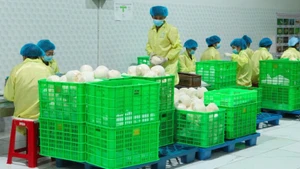Immediate challenges
Dr Nguyen Quoc Viet, Deputy Director of the Vietnam Institute for Economic and Policy Research (VEPR), noted a positive trend in the Purchasing Managers’ Index (PMI), reflecting a surge in imports to prepare for orders in 2025. This trend indicates that Vietnamese exporters are well-positioned for export orders through April or May 2025.
“The success in import-export in 2024 partially stems from businesses stockpiling imports early, influenced by predictions of Trump’s re-election,” Dr Viet explained. He added that Vietnam could still achieve its 2025 import-export goals, possibly exceeding 2024 levels.
However, Vietnam could face pressure from mid-2025 if Trump delivers on promises to tighten trade and investment policies with the aim to bring manufacturing back to the US. This could lead to a retreat of foreign capital, particularly indirect investment, back to the US. Whether trade flows and investments would continue to spread risk to ASEAN countries, including Vietnam, remains uncertain.
Additionally, Vietnam faces risks of being targeted in the context of US-China tensions, given that China remains Vietnam’s largest trade partner for both imports and exports. If China is affected by Trump’s policies, Vietnam could face specific challenges.
Meanwhile, Europe remains mired in a crisis stemming from the Russia-Ukraine war. Even if the conflict subsides next year, the economic repercussions will not be resolved quickly. Political instability in major European economies such as Germany, France, and the UK further exacerbates uncertainties.
Policies such as the European Green Deal, the Carbon Border Adjustment Mechanism (CBAM), the Circular Economy Action Plan, and the Biodiversity Strategy for 2030 are reshaping global economic and trade practices. These policies not only demand lower emissions but also stricter social and environmental standards, requiring exporting countries to adapt production methods to meet higher demands.
Prioritising green finance mobilisation
In this context, concerns arise about Vietnam’s ability to diversify its export markets and avoid over-reliance on existing supply chains.
“Investments in market research to deepen existing markets and identify new ones are essential,” suggested Dr Nguyen Quoc Viet. He emphasised the importance of increasing the scale and proportion of high-value goods while reducing export costs, improving quality, boosting deep processing, and developing brands to enhance value addition.
Agreeing with this view, expert Nguyen Thuong Lang stressed the need to develop domestic production capacity, increase localisation, and establish industries to replace imports. Building a resilient and independent national industrial base capable of producing large export volumes under favourable trade conditions must be a long-term strategy. Businesses must actively adapt to improve trade balances across various market segments.
Vu Ba Phu, Director of the Trade Promotion Agency (Ministry of Industry and Trade), advised businesses to identify short and medium-term export markets. He underscored the mandatory ‘green standards’ for markets like the EU, stressing that compliance with green transitions and anti-deforestation requirements will become essential from 2026 to 2028. Other major markets, such as Japan, the Republic of Korea, the US, and China, are also moving toward green standards and sustainable development, necessitating long-term preparations from businesses.
Currently, Vietnam’s green economy accounts for only 2% of its overall economic structure, while the brown economy dominates with 98%. Although Vietnam’s green economy is growing at a rate of 12–13%, its global position and green infrastructure remain underdeveloped. Associate Professor, Dr Nguyen Dinh Tho, Director of the Institute of Strategy and Policy on Natural Resources and Environment (Ministry of Natural Resources and Environment), highlighted this as a significant challenge for the maintenance of trade and investment in the future.
Thọ emphasised that businesses must prioritise the mobilisation of green finance and technology, enhancing their capacity to absorb green funding and utilising green technologies to meet the demands of transitioning to a circular economy.
















